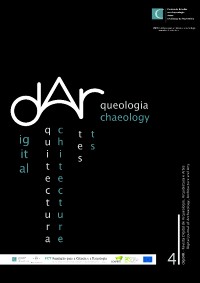Please use this identifier to cite or link to this item:
https://hdl.handle.net/10316.2/43051| Title: | Investigação arqueobotânica dos sedimentos arqueológicos de Paço dos Lobos da Gama: um arrabalde islâmico da cidade de Évora (séculos XI-XII) | Other Titles: | Archeobotanical research of the archaeological sediments of Paço dos Lobos da Gama: an islamic suburb of the city of Évora (11th-12th centuries) | Authors: | Coradeschi, Ginevra Mourer, Anne-France Santos, José Rui Lopes, Gonçalo Vignola, Cristiano Sadori, Laura Dias, Cristina |
Keywords: | Archaeobotany;Plant macroremains;Diet;al-Āndalus;Arqueobotânica;Macrorestos vegetais;Dieta alimentar;al-Āndalus | Issue Date: | 2017 | Publisher: | Imprensa da Universidade de Coimbra | Abstract: | Paço dos Lobos da Gama is a seventeenth-century manor house, built by the Lobos da Gama family. It’s located in the city center of Évora in Rua Serpa Pinto. In 2008 the area was subjected to a rescue archaeological excavation, which continued during the following year. The interventions focused mainly on the backyard behind the property. The area 6 revealed an important set of archaeological remains dated from the 1st to 2nd centuries AD until the end of the Modern times, with special emphasis on the Islamic period. The plants macro remains, which are main subjects of this study, come exclusively from Islamic contexts. The archaeological contexts investigated, except for one unit, belong to negative structures. Among all, the septic tank was particularly rich in mineralized seeds and fruits, mostly belonging to fruit trees/shrubs. This study is intended to characterize the use and consumption of plant foods by the Islamic community living in the area. It also seeks to better understand the structural contexts in which the samples were collected. The aspects related to the exploitation of the wood resources, as well as those of the site, are also discussed. The study is still ongoing, and only some preliminary results are presented here. O Paço dos Lobos da Gama é uma residência senhorial do século XVII, construída pela família Lobo da Gama. Situa-se sensivelmente a meio da Rua Serpa Pinto, em Évora. Entre 2008 e 2009 foi alvo de escavações arqueológicas de emergência que se concentraram principalmente no logradouro, atrás do imóvel. Em particular o sector 6 forneceu um conjunto importante de vestígios arqueológicos dos séculos I-II d.C. até ao final da Época Moderna, com especial destaque para o período islâmico. Os macrorestos vegetais, objeto deste estudo provêm exclusivamente de contextos islâmicos que, excetuando uma unidade estratigráfica, pertencem a estruturas negativas. Entre todas, destaca-se uma fossa séptica de onde provêm os sedimentos analisados que se revelaram particularmente ricos em sementes e frutos mineralizados, na maior parte pertencentes a arvores/arbustos de fruto. O estudo destina-se sobretudo à caracterização do uso e consumo de vegetais por parte desta comunidade entre o final do século XI e o princípio do século XII. São também relevantes os aspetos relacionados com a exploração e uso da madeira. As análises estão ainda a decorrer, pelo que serão aqui apresentados somente os resultados preliminares. |
URI: | https://hdl.handle.net/10316.2/43051 | ISSN: | 2182-844X (PDF) | DOI: | 10.14195/2182-844X_4_4 | Rights: | open access |
| Appears in Collections: | digitAR: Revista Digital de Arqueologia, Arquitectura e Artes |
Files in This Item:
| File | Description | Size | Format | |
|---|---|---|---|---|
| investigacao_arqueobotanica_dos_sedimentos_arqueologicos_de_pa_o_dos_lobos_da_gama.pdf | 679.62 kB | Adobe PDF |  |
Items in DSpace are protected by copyright, with all rights reserved, unless otherwise indicated.
